Yves GARY Hits: 7826
Category: AMERICA
 Trials inconclusive
Trials inconclusiveAs agreed in the contract, the shipyard has organized trials for the America. It's against the Maria, Commodore Stevens' fast sloop, which, in smooth water in the neighborhood of Sandy Hook, easily outsailed the new schooner. She is said to have sailed completely around the schooner three times in a short distance.
This did not discourage the owner of the America who thought that Maria would have distanced any opponent in these circumstances.
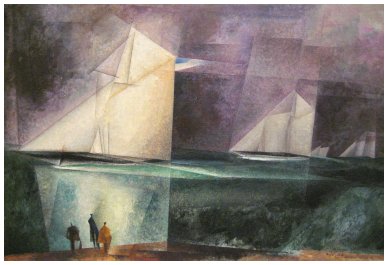 The sloop Maria
The sloop MariaThe Maria was described as being "the fastest yacht afloat". She was about 18 feet longer on the water-line than the cup racers of the present day, and held the record throughout her career, and for many years after its close, as the largest single-stick vessel ever built. In equipment she represented ideas far in advance of the period in which she flourished, having, among other innovations of equipment, hollow spars, outside lead ballast, and crosscut sails.
The Maria was designed in 1844 by Robert Livingston Stevens, working in conjunction with his brothers John C. and Edwin A., for whom the vessel was built by William Capes in his yard in Hoboken. She was launched in 1845, and began her racing career Oct. 6th, 1846, in the first amateur, or Corinthian, regatta of the New York Yacht Club, beating the fleet by an hour over a 40-mile course from the club-house in Hoboken, up the Hudson to Fort Washington, and down to the Narrows and back.
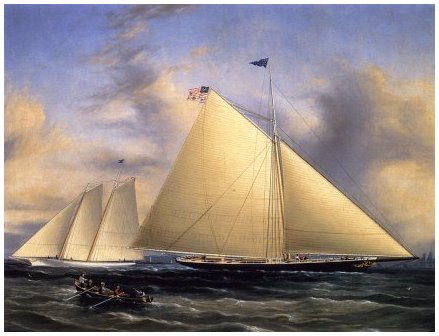 As originally built the Maria had a full, round bow, though with a shallow and easy entrance, in eflfect not unlike the "scow" bow of racers of to-day, her draft at the cutwater being only 8 inches. Her original lines are said to have been suggested by those of the North River sloop Eliza Ann, which, though not a yacht, showed great speed for those days. When launched the Maria was 92 feet long on deck. In 1850 she was lengthened by the addition of 18 feet to her bow, which made it long and sharp. Her dimensions were then : Length on deck 110 feet, waterline 107.9, beam 26 feet 6 inches, depth 8 feet 4 inches, greatest draft 5 feet 2 inches. Her centre-board, 24 feet long, with a draft of 20 feet, was heavily weighted, and w.is raised by the aid of strong spiral springs from which one end was suspended. Her outside lead ballast was fixed to the hull in strips, and covered with copper sheathing. The Maria was heavily sparred, her mast being 92 feet long, and 2 feet 8 inches diameter at the deck.
As originally built the Maria had a full, round bow, though with a shallow and easy entrance, in eflfect not unlike the "scow" bow of racers of to-day, her draft at the cutwater being only 8 inches. Her original lines are said to have been suggested by those of the North River sloop Eliza Ann, which, though not a yacht, showed great speed for those days. When launched the Maria was 92 feet long on deck. In 1850 she was lengthened by the addition of 18 feet to her bow, which made it long and sharp. Her dimensions were then : Length on deck 110 feet, waterline 107.9, beam 26 feet 6 inches, depth 8 feet 4 inches, greatest draft 5 feet 2 inches. Her centre-board, 24 feet long, with a draft of 20 feet, was heavily weighted, and w.is raised by the aid of strong spiral springs from which one end was suspended. Her outside lead ballast was fixed to the hull in strips, and covered with copper sheathing. The Maria was heavily sparred, her mast being 92 feet long, and 2 feet 8 inches diameter at the deck.
For the first 20 feet it was bored out to a diameter of 12 inches, in the next 20 feet to 10 inches, and the rest of the way to 7 inches. Her mainboom was 95 ftet long and hollow, being made of white oak staves, dowelled and hooped with iron, strengthened with inside trusses, and outside rods and struts, and nearly nine feet in circumference in its thickest part. Her gaff was 61 feet long, and bowsprit 38 feet outboard, entering the hull below decks.
The area of her mainsail was 5790 square feet, and of her jib 2100 square feet, making a total working sail-spread of 7890 square feet. She had a small working-topsail, but it was rarely set. On her mainsheet traveller was a rubber compressor to take up strain, the first one used on a yacht. She steered with a 12-foot tiller, and to prevent her from yawing when off the wind she had a small centre-board aft.
 The Maria rarely met defeat, and it was claimed for her that in smooth water with a strong breeze she sometimes logged "nearly 17 knots", which may have been rather a strong claim. In the trials with the America she is said to have sailed completely around the schooner three times in a short distance. She was essentially a smooth-water boat, and in heavy weather was no match for the America or any other smart schooner.
The Maria rarely met defeat, and it was claimed for her that in smooth water with a strong breeze she sometimes logged "nearly 17 knots", which may have been rather a strong claim. In the trials with the America she is said to have sailed completely around the schooner three times in a short distance. She was essentially a smooth-water boat, and in heavy weather was no match for the America or any other smart schooner.
Commodore Stevens delighted Co sail the great sloop, and was a familar figure to frequenters of New York. Bay, standing at her helm, his broad-brimmed hat flapping in the wind, and his face alight with animation as he watched his vessel bowl along, passing even steamers who tried conclusions with her.
The Maria is said to have cost the Stevens brothers in all about $100,000. She was frequently altered and improved, and always represented advanced ideas. Owing to the size of her sail-spread she was dismasted several times. She was finally rigged as a schooner, and in the 6o's was sold, and renamed Maud.
She then engaged in the fruit trade between New York and Honduras ports, and in October 1870, when bound for New York with a cargo of cocoanuts, she was lost at sea, with all hands.
Three paintings on the subject of Leonard J. Pearce |
||
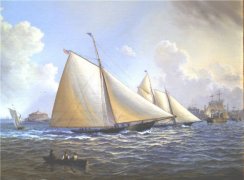 Trial-horse 'Maria' 1851 |
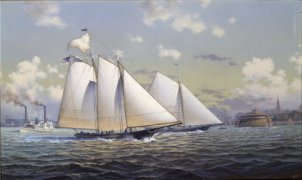 'America' on test 1851 |
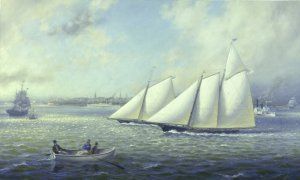 ‘America’ v ‘Maria’ 1898 |
Zoom on the race and the Maria |
||
John Mecray New York Harbour |
Shane Michael Couch AMERICA vs MARIA - New York Harbor |
Shane Michael Couch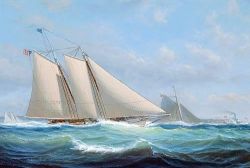 America and Maria Racing in New York Harbor |
Frederick S. Cozzens The Early Racers Maria. America. Una. Ray. |
Thomas S. Robins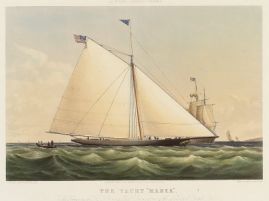 The yacht 'Maria' |
Currier and Ives The yacht "Maria" 216 tons |
The Maria affords an interesting basis for comparative study of the progress made in racing sloops. Her memory should ever be kept green by American yachtsmen.
